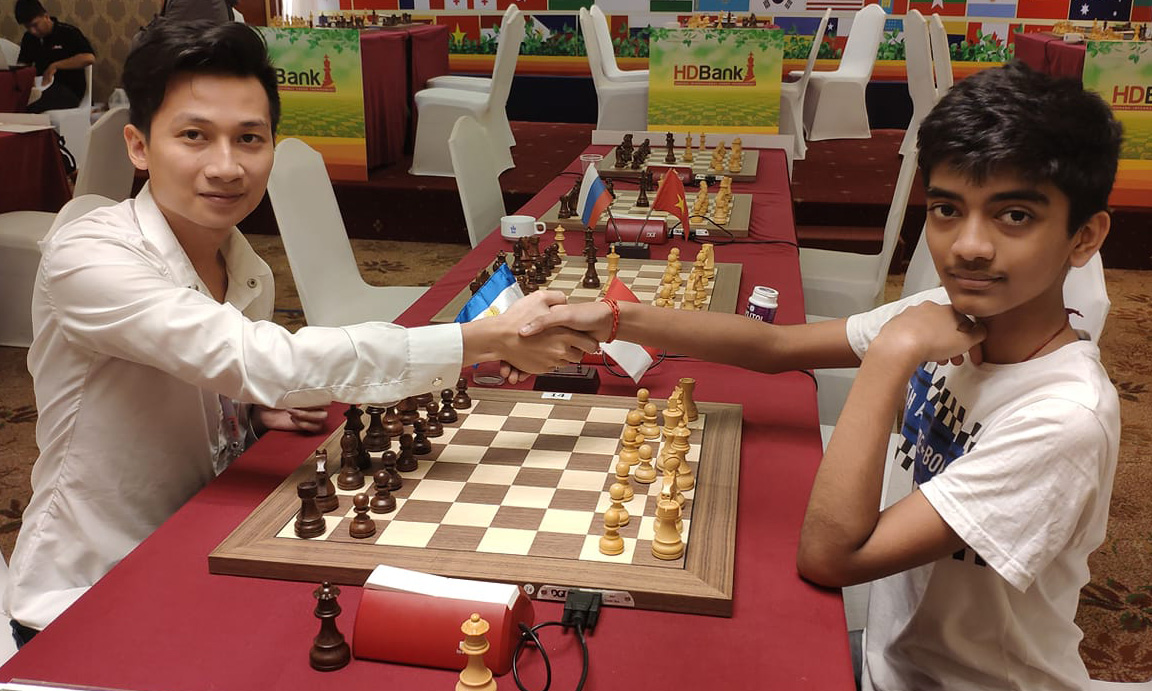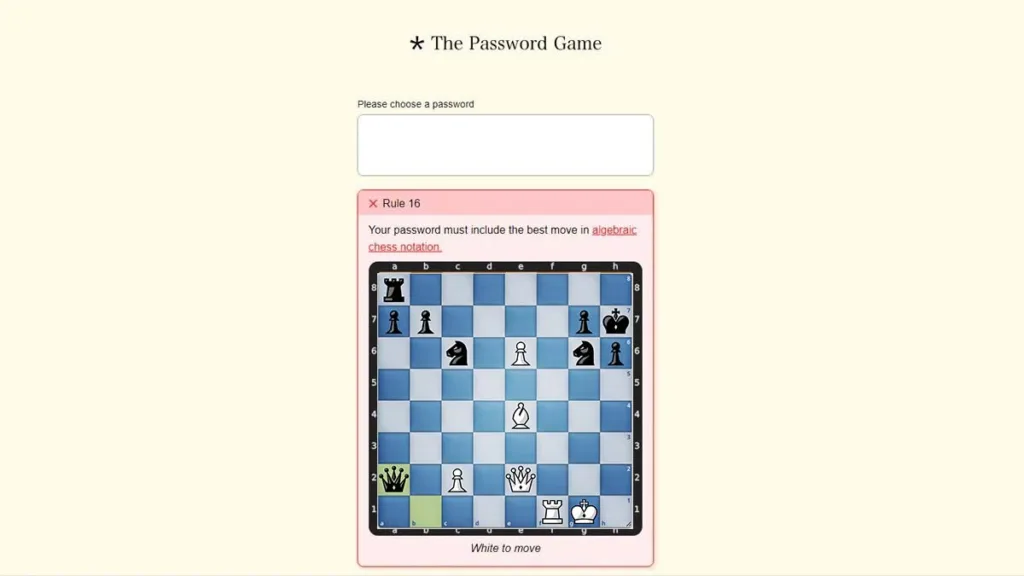So you’ve made it to Rule 16 in The Password Game. Congratulations! But now the game suddenly throws a wild curveball:
“Enter the best move in algebraic chess notation.
Wait… chess??
If your brain just screamed “I don’t play chess!”, don’t panic. This article is your crash course to help you solve Rule 16, from absolute zero.
- What Is Rule 16 Asking You to Do?
- Step-by-Step Guide to Solving Rule 16
- 1. Take a Screenshot of the Chess Position
- 2. Meet Your Secret Weapon: Lichess Board Editor
- 3. Quick‑Start Guide to Chess Coordinates
- 4. Algebraic Notation in One Glance
- 5. PGN and FEN: What Those Acronyms Mean
- 6. Common Pitfalls to Avoid
- 7. One‑Minute Workflow Recap
- 8. Still Stuck? We Have Your Back
- 9. You're Already Playing Chess. Why Not Go Further?
What Is Rule 16 Asking You to Do?
You’re shown a chess board with a specific position, and you’re asked to type in the best next move for the side to play. The move must be written in algebraic notation, the language chess players use to record moves.
Your password won’t be accepted until you enter the correct best move, just like a chess engine would.
Step-by-Step Guide to Solving Rule 16
1. Take a Screenshot of the Chess Position
As soon as Rule 16 appears and shows you a board:
- Take a screenshot of the board.
- Make sure the pieces, board coordinates (a-h, 1–8), and turn to move are visible.
2. Meet Your Secret Weapon: Lichess Board Editor
- Open https://lichess.org/editor.
- Click “Clear board.” You now have a blank canvas.
- Re‑create the puzzle position shown in The Password Game by dragging each piece to its square.
- Pieces are at the bottom of the page.
- If the puzzle shows a black piece on g7, drag the black pawn to the g‑file, 7th rank.
- Set the side to move. Click the little king icon under the board until it shows the color whose turn it is (white or black).
- Press “Analyze board,” then toggle “Computer analysis.”
- The engine will reveal the best move at the top of the move list. Copy it exactly. Done.
3. Quick‑Start Guide to Chess Coordinates
| Board File | Letter | Board Rank | Number |
|---|---|---|---|
| Vertical columns | a–h (left to right from White’s view) | Horizontal rows | 1–8 (near to far from White) |
So “g7” is the square in the g‑file and 7th rank. Picture a spreadsheet with lettered columns and numbered rows.
4. Algebraic Notation in One Glance
| Symbol | Piece | Example | Meaning |
|---|---|---|---|
| K | King | Kf2 | King moves to f2 |
| Q | Queen | Qxd5 | Queen captures on d5 |
| R | Rook | Re8+ | Rook to e8 with check |
| B | Bishop | Bc4 | Bishop to c4 |
| N | Knight | Nf3 | Knight to f3 |
| (no letter) | Pawn | e4 | Pawn to e4 |
| x | Capture | Nxe5 | Knight captures on e5 |
| + | Check | Qh7+ | Check the king |
| # | Checkmate | Qh7# | Checkmate |
| =Q/R/B/N | Promotion | e8=Q | Pawn promotes to queen |

You might also see “0‑0” (castle king side) or “0‑0‑0” (castle queen side). They rarely appear in Rule 16 positions, but now you know.
5. PGN and FEN: What Those Acronyms Mean
- PGN (Portable Game Notation)
A text log of an entire game: moves, comments, even round details. Think of it as a full movie script. Your answer in The Password Game would be something like, Qe3, or Rd1,… - FEN (Forsyth‑Edwards Notation)
A single‑line snapshot of one position: piece layout, whose turn, castling rights, etc. Think of it as a freeze‑frame.
Example:rnbqkbnr/pppp1ppp/8/4p3/4P3/5N2/PPPP1PPP/RNBQKB1R w KQkq - 2 2
Lichess can import either one. For Rule 16 you usually reconstruct the board manually, but if the game supplies a FEN you can paste it straight into the editor.
6. Common Pitfalls to Avoid
- Wrong side to move. Double‑check the little “White to move / Black to move” toggle.
- Piece color mix‑up. Knights look similar. Queens and kings are also easy to swap.
- Forgetting promotion. If a pawn sits on the 8th or 1st rank it is usually no longer a pawn. Promote it to the indicated piece.
- Copying the second‑best move. The Lichess engine lists several moves. Only the top line (depth number in green) is “best.”
7. One‑Minute Workflow Recap
- Clear board → drag pieces.
- Set side to move.
- Analyze → Computer analysis.
- Copy the first line of engine output.
- Paste into The Password Game and proceed to the next rule.
8. Still Stuck? We Have Your Back
Send us a screenshot and we will solve it for you:
- X (Twitter): https://x.com/attackingchess
- Facebook: https://www.facebook.com/profile.php?id=61571473500302
- Instagram: https://www.instagram.com/attackingchessofficial/
- Bluesky: https://bsky.app/profile/attackingchess.bsky.social
9. You’re Already Playing Chess. Why Not Go Further?
If you just solved Rule 16, congratulations: you’ve already dipped your toes into the world of chess. That’s how it starts for many people, accidentally.
You don’t need to become a grandmaster to enjoy chess. With just a little practice, you can learn how to spot checkmates, set traps, and even beat your friends. If this puzzle sparked your curiosity, we’d love to help you take the next step.
Visit our Chess 101 category. It’s packed with fun guides, opening tricks, game breakdowns, and bite-sized tips for beginners and casual players. Whether you’re here to get better or just enjoy the beauty of the game, we’ve got something for you.

I’m Xuan Binh, the founder of Attacking Chess, and the Deputy Head of Communications at the Vietnam Chess Federation (VCF). My chess.com and lichess rating is above 2300. Send me a challenge or message via Lichess. Follow me on Twitter (X) or Facebook.


2 thoughts on “How to Beat Rule 16 in The Password Game — Even If You Know Nothing About Chess”
Comments are closed.